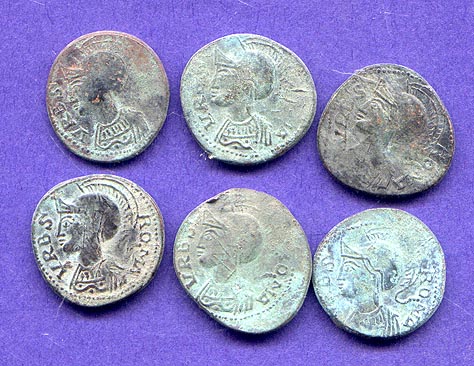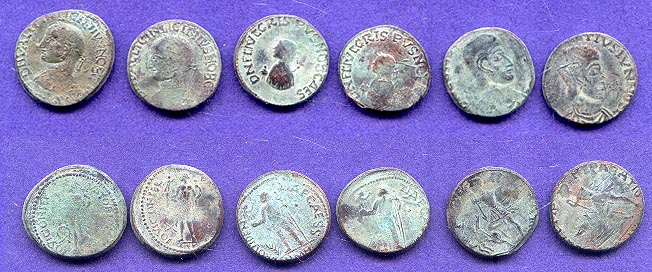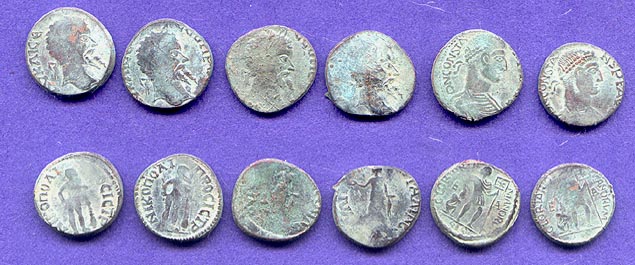Modern Forgeries
Turning Up in
Uncleaned Ancient Coin Lots.
This site shows a group of
suspect coins from a lot of 1,000 uncleaned ancient coins
that came on the market in late 2003. By posting what I
have encountered, I am hoping both collectors and dealers
will be better able to identify what appears to be a group
of modern forgeries of late Roman and early Byzantine
bronzes dumped enmasse into the market via uncleaned coin
lots. Many thanks to Tom Schroer for his help in ID'ing the
Byzantine forgeries. In early April 2004, I discovered a
tiny AE-4 in another 1,000 coin lot of either Theodosius II
or Valentinian III with crucifix reverse that is an obvious
fake from this same series.
Source: Eastern Europe, most likely Bulgaria.
In December 2003, I discovered 316 coins in a 1,000
uncleaned coin lot that are clearly modern forgeries. Since
then, I have encountered individual stray pieces from the
same forgery source in other uncleaned lots I have handled.
These fakes continue to appear even six years later in 2009
in various "Uncleaned Coin" auctions on eBay.
Below is a sampling of 8 Jovian AE-3's - all struck from a
single die. Originally I thought these and the other
forgeries were cast but, on closer examination, they appear
to be struck fakes.
Suspect Jovian group -
Obverse
Suspect Group Jovians - Reverse

The die links here are clear, note the mouth and lips on
the obverse and the "O" in VOT on the reverse.
Below is an authentic uncleaned Jovian AE-3

Suspect group of Justinian 20 nummia pieces. Style clearly
renders these as fakes (note the eye) as well as identical
dies.


Below is a set of six Urbs Roma types with Wolf & Twins
reverse. Again, style is completely out of keeping with the
authentic series as well as the clear die links indicating
these coins were all struck from the same die.


Below is an authentic uncleaned Urbs Roma issue from the
Siscia mint.

The following
information will serve as a guide for spotting these fakes
in uncleaned lots:
1. They are mostly AE-3's (15-17 mm,) some AE-3/4's (12-14
mm) with a few early Byzantine AE-2's (19-21 mm) and
AE3/4's (13-16 mm) along with a significant number of
Severan provincial issue forgeries (14-16mm.)
2. The flans, on examination, are not ancient but modern,
too perfect for an ancient coin that has lain in the ground
for 1500 years.
3. These fakes show no patinas but rather a modern chemical
induced toning that is often blue. The toning has proved
corrosive over time with several of the smaller coins
developing a liquified coating resulting from a reaction
with the planchet metal. Dirt doesn't adhere to the coins,
but rather brushes off with a few swipes of the toothbrush
indicating the coins have been dirtied to imitate
authenticity. In addition, the
suspect coins, although they purportedly range in date from
over a three hundred year period, all display the exact
same toning, level of wear, flan types and style.
4. Currently I have identified 20 types, each similar type
(say Urbs Roma w/wolf & twins) coming from the same
dies (known as die links.) This is an uncommon occurrence
in ancient coins but to have it occur over and over in 300+
coins from a single uncleaned lot supposedly collected from
multiple sources, not possible.
5. These all look like they are struck forgeries, with
large areas of the flans smooth. Some have clearly been
clipped off the molten metal with tips of metal left where
the liquid metal flowed out from between the dies.
6. Most importantly, the style of the engraving is not
ancient Roman, neither is that of the lettering in the
inscriptions. They are also not ancient barbaric imitations
(the uniformity of flan compostion, artificial toning, and
similarity of condition despite supposedly originating over
a 300 year period, eliminate them as barbaric imitations)
but similar to known forgeries to come out of Bulgaria.
A catalogue of the coins found in the 1,000 coin
lot.
Some of the coins are purely ephemeral or "mules" with the
reverse types not matching issues of the obverse emperor or
reverse types from one emperor paired with obverses of
another. So far I have identified 20 forgery types. The
number in parenthesis is the count and the percentage of
the 316 total to give an indication of scarcity. Percents
have been rounded to one decimal place.
This may not be an all inclusive list since a total of
roughly 20,000 coins were imported, the percentage of which
were fakes is uncertain. Other types may still be
unidentified. The ones known to me are listed below:
AE -3 Urbs Roma, Wolf & Twins reverse ( 23 - 7.3% )
AE-3 Valens, Victory advancing left reverse, Securitas
Reipublicae ( 36 - 11.4% )
AE-2 Justinian, K nummia reverse ( 2 - 0.6% )
AE-3 Jovian, Vot V Mult X in wreath reverse ( 19 - 6.0% )
AE-3 Justinian "H" 8 nummia of Thessalonika ( 23 - 7.3% )
AE-3/4 Justin I with Chi Rho reverse, Constantinople ( 7 -
2.2% )
AE-4 Justinian decanummia with "1" Anno xxii reverse,
Constantinople mint( 11 - 3.5% )
AE-3 Constantinus I, altar and phoenix, Fel Temp reverse (
25 - 7.5% )
AE-3 Constantinopolis, victory reverse ( 15 - 4.7% )
AE-3 Valentinian II with Concordia Avgg reverse ( 18 - 5.7%
)
AE-3 Constantius II Fel Temp Reparatio reverse, soldier
spearing fallen horseman ( 24 - 7.6% )
AE-3 Licinius II. Iovi Conservatori reverse ( 17 - 5.4% )
AE-3 Crispus, Providentiae Caess reverse ( 7 - 2.2% )
AE-3 Septimius Severus Provincial ( 30 - 9.5% )
AE-3 Septimius Severus Provincial Variation ( 10 - 3.2% )
AE-3 Constans, Gloria Romanorum reverse ( 29 - 9.2% )
AE-3 Constantinus I Virtus Exercitu reverse ( 12 - 3.8% )
AE-3 Constantius II, Victoriae DD AVGG QNN reverse ( 11 -
3.5% )
AE-3 Constantinus I, Gloria Exercitus, pair soldiers
w/standards reverse. ( 10 - 3.2% )
AE 3/4 Pentanummia Justin II w/reverse of Justinian
(Antioch mint) Fantasy "mule." ( 7 - 2.2% )
AE-4 Valentinian III/Theodosius II crucifix reverse
(discovered April 11, 2004 in a separate 1,000 coin lot.)
(1 coin)
The most plentiful of the forgeries appear to be the
Severan provincials, the Valens Victory advancing left, and
the Constans Gloria Romanorum. The least plentiful is the
AE-2 size 20 nummia K reverse of Justinian with only two
pieces represented and the AE-4 Valentinian/Theodosius
crucifix reverse.
Photos of
the coins not appearing above are below. Pair coins are
displayed in order to show die links.
Set 1 below from left to right they are:
AE-3/4 Justin I with Chi Rho reverse, Constantinople.
AE-3 Valens, Victory advancing left reverse, Securitas
Reipublicae.
AE-4 Justinian decanummia with "1" Anno xxii reverse,
Constantinople mint.

Set 2 below from left to right are:
AE-3 Constantinus I, altar and phoenix, Fel Temp reverse.
AE-3 Constantinopolis, victory reverse.
AE-3-Valentinian II with Concordia Avgg reverse.

Set 3 below from left to right are:
AE-3 Licinius II. Iovi Conservatori reverse.
AE-3 Crispus, Providentiae Caess reverse.
AE-3 Constantius II Fel Temp Reparatio reverse, soldier
spearing fallen horseman.

Set 4 below from left to right are:
AE-3 Septimius Severus Provincial.
AE-3 Septimius Severus Provincial Variation.
AE-3 Constans, Gloria Romanorum reverse.

Set 5 below from left to right are:
AE-3 Justinian "H" 8 nummia of Thessalonika.
AE-3 Constantine I, Virtus Exercitu reverse.
AE-3 Constantius II, Victoriae DD AVGG QNN reverse.

Set 6 below from left to right includes:
AE-3 Constantine I, Gloria Exercitus, pair soldiers
w/standards reverse.
Samples illustrating modern clipping and metal tips on
flans left over from striking/casting.

Set 7 below from left to right:
AE 3/4 Pentanummia Justin II w/reverse of Justinian
(Antioch mint) Fantasy "mule."

Set 8 below from left to right:
AE-4 Valentinian III/Theodosius II cross reverse fake.
Real AE-4 Valentinian III with cross reverse.

A note at the end - 2009. Although first
appearing in large numbers during 2003-2004, these
forgeries continue to show up in uncleaned lots and smaller
offerings on a regular basis on e-Bay. These fakes should
put to rest any contention that there are coins that are
too cheap or too small to be worth forging.
An extreme example is the crucifix coin in set 8. This 9mm
coin (that's nine millimeters, one of the little nodules)
is a fairly common Valentinian III, Theodosius II AE-4 with
crucifix reverse.
Summer 2009 - As added information that
these coins are still "circulating," below are a pair that
recently turned up in an otherwise decent lot of uncleaned
coins. Thanks to Gene Mayo for the heads up and the
photographs.
Both are AE-3
size. The second coin is clearly the same as the
sample in picture set five, the third pair,
Constantius pair victories reverse. The first coin
with the red toning matches the first coin in picture
set five, Justinian 8 nummia of Thessalonika.
Bob Bischoff
petroni912@aol.com


